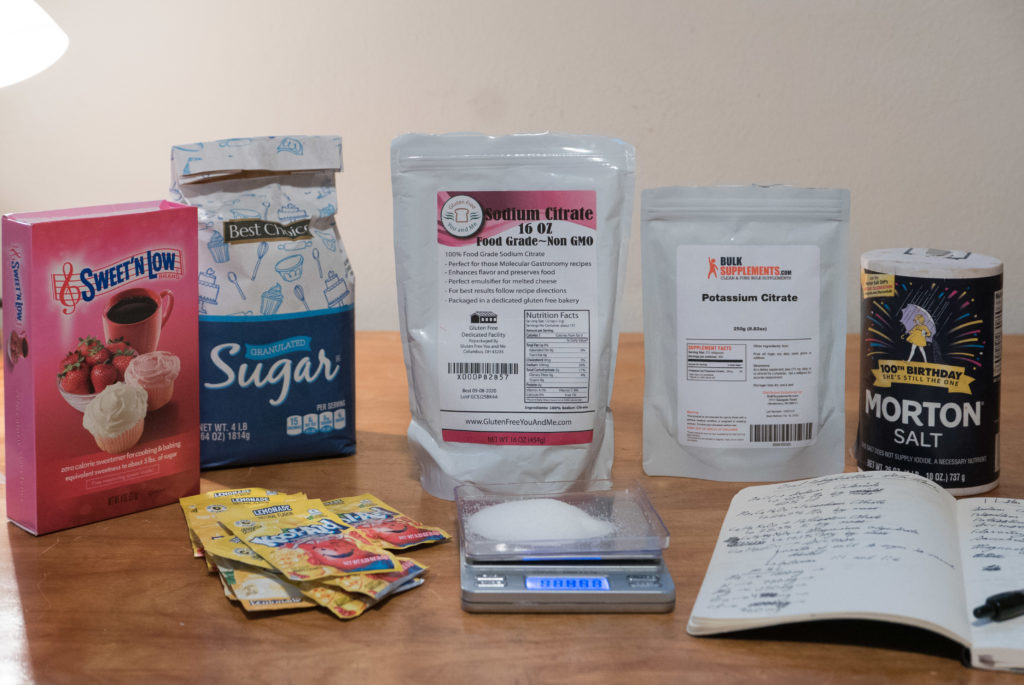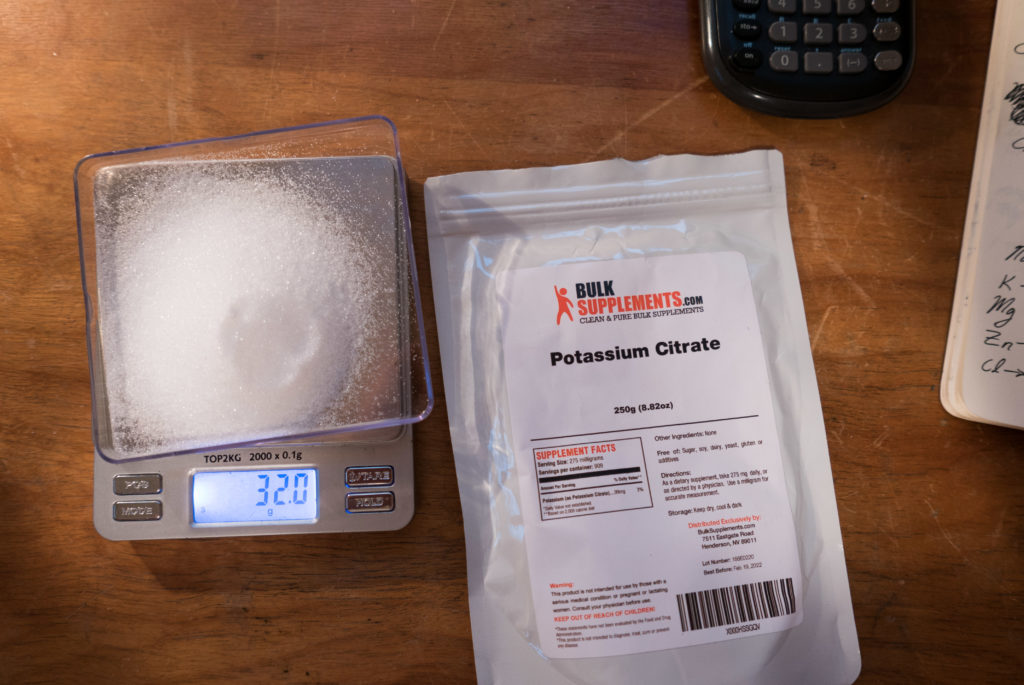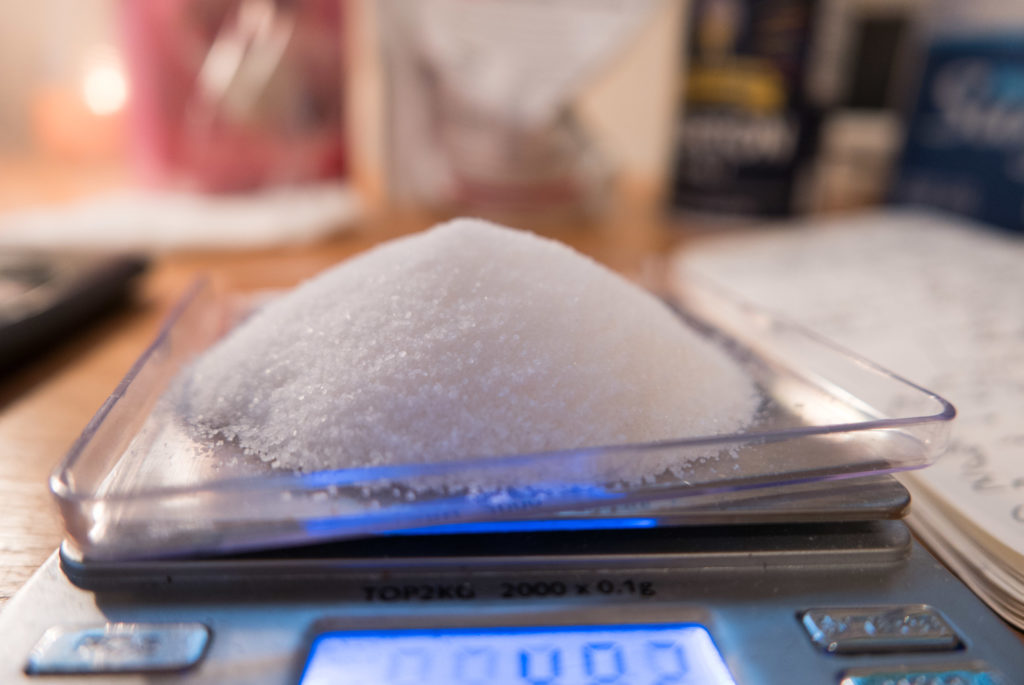This ORS (oral rehydration solution) is 10 times cheaper than Pedialyte and contains a wider array of electrolytes. Gatorade, in comparison, is a low electrolyte, high sugar mix and has nothing on this ORS besides marketing.
I wanted something to mute hangovers or to drink after a long day of sweating. But I don’t want to spend $4 on Pedialyte or drink a gallon of sugary Gatorade. This ORS closely follows the nutritional profile of Pedialyte. The ingredients are similar too, excluding Pedialyte’s additives to improve solubility and shelf life. As a powder, it is more convenient. Compared to a $4 bottle of Pedialyte, 1 liter of this ORS costs about 41 cents!
I’m not a doctor and don’t know much about anything. So be careful. Nonetheless, all these ingredients are commonly used in food and safe to ingest, so I feel comfortable with these mixes.
There Are More Electrolytes Than Sodium
Almost every recipe for an ORS starts with “you need to replenish your electrolytes.” Then, they follow the same recipe – salt, sugar, and water. Example recipes here, here, and here.
Yet there are more electrolytes than Sodium and Chloride. Some important electrolytes:
- Sodium (more info)
- Chloride
- Potassium (more info)
- Magnesium
- Calcium
- Phosphate/Phosphorus
- Bicarbonate
In my recipe, I included Sodium, Chloride, Potassium, Magnesium, and Zinc. Pedialyte includes zinc. Zinc is lost in sweat and a deficiency is found in alcoholics. Exercise and hangover recovery are my main uses of this ORS so adding zinc makes sense. You can skip this and instead occasionally take a multivitamin.
(Side note – some recipes use baking soda to include sodium and bicarbonate – two important electrolytes. Bicarbonate is secreted by the stomach but additional bicarbonate can regulate water and calcium absorption. This is often used as a replacement [page 350] when Sodium Citrate is not available)
Electrolytes By Mass Per Compound
| Powder | Compound | Mass of Powder | Electrolyte | Percent by mass | Mass of Electrolyte | Recommended Daily Allowance / AI | Contents of 1L Pedialyte | Ref |
|---|---|---|---|---|---|---|---|---|
| Sodium Chloride | NaCl | 1.6g | Na | 0.4 | 640mg (total of 1010mg) | 1500mg | 1035mg | [ref] |
| Sodium Chloride | NaCl | 1.6g | Cl | 0.6 | 960mg | 2300mg | 1225mg | [ref] |
| Trisodium Citrate | Na3C6H5O7 | 1.38g | Na | 0.267 | 370mg (total of 1010mg) | 1500mg | 1035mg | [ref] |
| Potassium Citrate | C6H5K3O7 | 2g | K | 0.383 | 750mg | 4700mg | 780mg | [ref] |
| Magnesium Glycinate | C4H8MgN2O4 | 1.77g | Mg | 0.141 | 250mg | 420mg | NA | [ref] |
| Zinc Gluconate | C12H22O14Zn | 55mg | Zn | 0.143 | 7.8mg | 11mg | 7.8mg | [ref] |
This table contains the electrolytes for our ORS. These electrolytes and minerals come in many forms. For example, you can buy 9 different types of magnesium supplements. I tried to mimic Pedialyte’s list of ingredients as closely as possible (using Sodium Chloride, Sodium Citrate, Potassium Citrate, and Zinc Gluconate).
The Recipe
| Ingredient | Quantity | Link | Cost per L |
|---|---|---|---|
| Sodium Chloride (Table Salt) | 1.6g | $0.004 | |
| Trisodium Citrate | 1.4g | [buy] | $0.033 |
| Potassium Citrate | 2g | [buy] | $0.112 |
| Sucrose (White Sugar) | 10g | $0.010 | |
| Flavoring (Lemonade Kool-Aid Powder) | 3g (half packet) | [buy] | $0.160 |
| Magnesium Glycinate | 1.8g | [buy] | $0.092 |
| Zinc Gluconate | 55mg | [buy] | $0.003 |
| Total - 20g | Total - $0.41 |
Breakdown
Sodium Chloride – Cheap source of both Sodium and Chloride. Used in both Gatorade and Pedialyte.
Trisodium Citrate – Source of Sodium that enhances the flavor. Found in Gatorade and Pedialyte.
Potassium Citrate – Source of Potassium found in Pedialyte. Gatorade uses Monopotassium Phosphate which provides the electrolyte Phosphorus.
Sucrose – Table sugar. Glucose helps with Sodium and water absorption across the intestines [ref] [ref]. You can find many differing opinions on the ratio of glucose to Sodium. The WHO ORS [page 350] has a ratio of 7.5:1. Rehydrate.org recommends an 8:1 mass ratio (derived from 1:1 molar ratio). Pedialyte uses dextrose (D-glucose) and has a ratio of 24:1. I use 10g of table sugar (sucrose) which contains 5g of glucose. Thus my ORS’s ratio is 5:1. Substitute sucrose for glucose to eliminate unnecessary fructose.
Flavoring – I used Kool-Aid lemonade packets for flavoring. One packet is enough for 2 liters of ORS. If you’re venturing enough, buy powered lemon juice.
Magnesium Glycinate – A popular and easily obtainable salt of Magnesium.
Zinc Gluconate – A popular and easily obtainable salt of Zinc.
Results
This ORS has a similar taste, nutritional profile, and ingredient list to Pedialyte. It provides Sodium, Chloride, Potassium, Magnesium, and Zinc. It is powdered instead of prebottled. It is 10x cheaper too.
Good luck and leave any thoughts or corrections in the comments below!



Hi,
I’m trying to replicate your table but can’t find a pedialyte ingredients list that matches yours exactly. This one: https://static.abbottnutrition.com/cms-prod/abbottnutrition-2016.com/img/Pedialyte%20EN_tcm1310-73180.pdf has a lot more sodium chloride and less trisodium citrate than your recipe, and it contains no zinc.
When was this article written? I’m curious now whether the Pedialyte formula has changed over time.
Thanks,
-mike
Mike,
This article was written in 2017. I don’t have the reference Pedialyte bottle and formula anymore, but the recipe you linked to is certainly different.
I found this image online. If I remember correctly, this was the same formula I referenced.
http://nssoee.org/wp-content/uploads/2017/11/pedialyte-diet-for-adults-best-of-diy-natural-pedialyte-recipe-for-baby-kids-adults-rehydrating-of-pedialyte-diet-for-adults.jpg
Hello,
I am trying to make my own electrolyte powder. How much water do you add to your recipe above? I appreciate the time and effort you put into this. I am hoping to duplicate liquid iv poder that is so expensive.
Thanks again.
Laureb
Lauren,
The recipe in this post is for 1L of ORS.
Hey man. I love everything you’re doing.
I followed this recipe and have to say not only is it not close to a pedialyte flavor, it taste significantly worse. Also after spending an hour or so researching each of the ingredients, some of your portions are significantly outside the range for recommended dosing. Potassium Citrate for example, maximum daily intake should be 275mg and typically is dosed around 100mg. If you have some references that say otherwise I’m very open to accepting them. Like I said, love everything you do. Just had to mention my experience. All the best.
James,
Sorry it didn’t work out for you. In my opinion, I think this solution tastes marginally better than Pedialyte (both of which taste likely salty fruit juice).
I referenced the nutritional label of Pedialyte. The quantity of potassium citrate in this recipe matches the quantity used in Pedialyte.
One bottle of Pedialyte contains 780mg of potassium and is provided by potassium citrate. 2g of potassium citrate contains 780mg of potassium, thus I chose to use 2g.
Thank you for this exhaustive list. Here’s a quick question. Is it possible to use all of the listed ingredients but eliminate the sugar? I love the effects of pedialyte when I’m dehydrated but I can’t consume the sugar. Will it still be as effective without the sugar? Thank you
Good question – I’m not sure how much less effective it would be without the sugar. The papers referenced in this page say sugar helps with absorption, but I don’t see them specifying exactly how much of a difference sugar makes.
Use glucose instead of sucrose, to eliminate fructose. Sucrose is (glucose-fructose).
No real reason to eliminate the fructose though. Lots of pseudo-nutritionist lore about fructose.